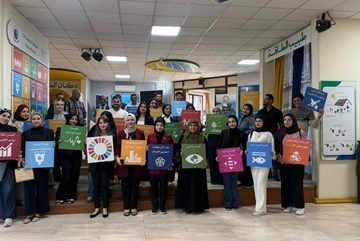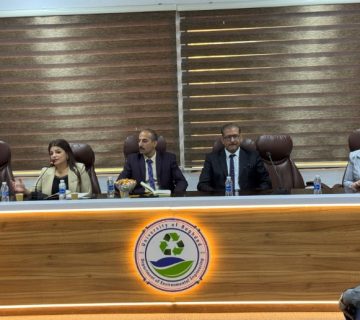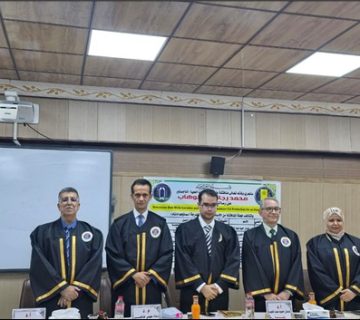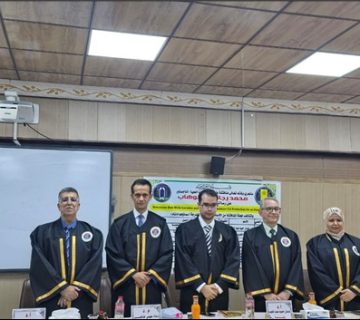Environmental Engineering Department at the College of Engineering, University of Baghdad, held Msc thesis examination titled:
“Evaluating soil contaminated in the southern Baghdad thermal power plant surrounding area using spatial analysis and pollution indices”
By the student Masara Dhiaa Butraus and supervised Assist.Prof.Dr. Hussien Jabbar Kadhim on Wednesday 18/9/2024, in the Environmental Engineering discussion hall. The examination committee consisted of Prof.Dr. Abeer Ibrahim Musa as Chairman, and the membership of Prof.Dr. Salim Hariz Jsam, and Lecturer.Dr. Mohammed Bahjat Abd Al-Kareem. After conducting the public discussion and listening to the student’s defense, the thesis was accepted. It was summarized as follows:
Heavy metals (HMs) pose global toxicity challenges, particularly in areas under significant human pressure. Consequently, pollutants accumulate on the soil surface, leading to soil pollution due to industrial activities, especially electric power plants and oil refineries that consume large amounts of fuel. Power plants emit significant air pollutants and cause air and soil pollution by using low-quality petrochemical fossil fuels like heavy oil. This study aims to assess the level of heavy metal contamination in the soil surrounding the South of Baghdad Power Plant (SBPP). 19 soil samples were collected from different impact zones at distances (1-2-3-5 km) in the direction of the prevailing winds in the area to investigate HMs including lead (Pb), cadmium (Cd), selenium(Se), chromium(Cr), cobalt(Co), copper (Cu), and arsenic(As), and Zinc, furthermore, soil characteristics like Alkalinity (pH), Electrical conductivity (EC) and organic carbon (Om) in the dry and wet season. Data analysis showed a significant increase in Pb, Cd, Se, and As concentrations in all soil samples compared to the global permissible limits. Were the average mean concentration for pb (1391.93), Cd (1830.9), Se (518.15), Cr (137.55), Co (46.28), Cu (118.41), As (704.48), and Zn (140.28) ppm In addition, the finding indicated that the soil’s HMs content was higher near the stations and decreased with distance from them. Statistical analyses indicate a significant positive correlation of pH with almost all heavy metals under study at p ≤ 0.01 and the correlation coefficient between the presence of Se with As and Pb had a highly significant positive effect (0.98) on the soil for the long-term accumulation schedule, indicating a common source of contamination, probably due to the combustion processes in the plant. The contamination indices Geo accumulation index (Igeo), Contamination factor index (CF), Pollution load index (PLI), and Potential Environmental Risk (RI) also showed that most of the soil samples were classified within the medium to very high contamination categories, with the highest levels of contamination recorded for cadmium, lead, selenium, and arsenic, respectively. More specifically, the contamination indices showed that chromium, copper, and (Zn) were classified overall, they were classified as moderate to considerable contamination, while all lead, cadmium, selenium, and arsenic samples were classified as very high contamination. The results of this study confirm, through using QGIS software to create spatial analysis seasonal distribution maps of all HMs elements and pollution indicators (PLI & RI), the existence of a significant environmental risk in the area surrounding the SBPP station due to severe pollution with heavy metals, which calls for urgent measures to reduce this pollution.
The recommendations of this thesis:
- Conducting more research on identifying and quantifying pollutants, and developing the necessary plans and programs to address them.
- Maintenance of all combustion units that cause emissions. And equipping stations with advanced filters that prevent the spread of these pollutants in the air and the surrounding environment.
- Adding treatment materials to refining operations in order to reduce heavy metal emissions from chimney openings.
- Impose maintenance on cars and cargo vehicles to reduce their exhaust emissions.
- To reduce the health impacts of air pollution, the Ministry of Health, the Ministry of Environment, and the Ministry of Energy must join forces to develop continuous air quality monitoring programs, provide necessary medical care to those affected, and implement community awareness campaigns on the importance of preserving the environment.
- Use the Geographic Information Systems (QGIS) program in environmental analysis and modeling, as the Geographic Information Systems program has become a very powerful tool in the field of environmental science and engineering.







